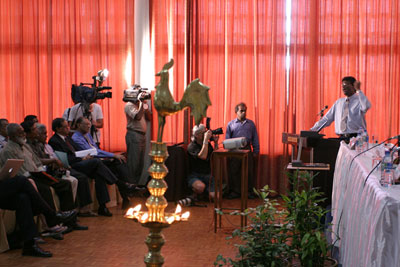The December 26, 2004 Indian Ocean Tsunami: Initial Findings on Tsunami Sand Deposits, Damage, and Inundation in Sri Lanka
Recovery and Planning for Future Tsunamis in Sri Lanka and Worldwide
The primary goal of the Sri Lanka ITST was to assist Sri Lanka through its scientific expertise, especially in developing new techniques for disaster mitigation and prediction. The data collected by the Sri Lanka ITST will help in planning for future tsunamis in Sri Lanka by better defining inundation zones and what segments of coast were hardest hit by the tsunami. Although the data collected is valuable, it is only the first step in improving the understanding of the December 26, 2004 Indian Ocean Tsunami in Sri Lanka.

The Sri Lanka ITST presented the intial results of their survey to the Minister of Science and Technology of Sri Lanka, 150 Sri Lankan scientist, and media in Colombo on January 15. The presentation and discussion lasted five hours. Photo courtesy of Bretwood Higman, University of Washington.
Other steps that could help the Sri Lankan government in making the difficult decisions on where (and what type) of development to allow in the tsunami impacted areas are:
- further analysis of data collected by the Sri Lanka ITST and by the Geological Survey & Mines Bureau of Sri Lanka;
- combining field data and remote sensing data to better define the spatial variability of tsunami inundation distances;
- numerical modeling, constrained by field data, of the spatial variability of the intensity of the Indian Ocean Tsunami in Sri Lanka;
- paleotsunami deposit studies to determine whether the Indian Ocean Tsunami was the largest tsunami that has impacted Sri Lanka—these studies would also determine how frequently Sri Lanka is impacted by tsunamis; and
- development of new techniques for refining predictions of which areas of Sri Lanka are most at risk from tsunamis—these techniques, although developed using the data from Sri Lanka, will be useful for improving assessment of tsunami risk in the United States and worldwide.
 |
 |
 |
 |

 Photos
Photos